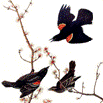Center, Internet, Wildlife Damage Management

Bird Control Seminars Proceedings
Document Type
Article
Date of this Version
September 1966
Abstract
We want to talk now about population principles; this is our main problem dealing with populations. We should discuss the general application of population principles and the management of bird populations. The reason we can discuss this is because many species follow established principles; population growth and later regulation of its size follow certain basic rules. Many pest species follow these principles, but not always to the letter. Populations of different species, as well as of a species, vary depending upon local conditions. Local environments dictate what population levels and the growth of populations will be. Minor variabilities still fit into the general picture.
To apply these principles we must consider the level of reduction desired in the pest population. This is determined usually by 1) eco¬nomic damage or 2) disease potential or much too often by 3) the budget. You can go from a complete reduction or local eradication of a species to a very minor change in the population level depending upon the methods you use. One of the major questions which I am sure most of you are faced with is: "Which method does what? " We'll briefly go through some of the basic principles of what we call population ecology. First, we'll consider the natural growth of a population. We can describe the theoretical natural growth of a number of animals compared to time by what we call an "S" shape or sigmoid curve. This shape is the result of a change in the rate of increase in the population. We have a very low population at the outset and it increases, and the reason we have an "S" shape is that the rate of in¬crease changes with time. So we can see that there is a maximum rate of increase at the mid-point. At the beginning of population growth we have fewer animals, and of course, a lower rate of increase. And, at mid-point, you have your maximum rate of increase. Looking at this theoretical graph we see that the population levels off near the end of our given time span. This is what is commonly referred to as the carrying capacity of a particular environment or how many animals the environment can support; the "K," some people call it. The carrying capacity changes with local conditions.

